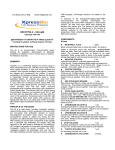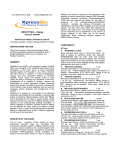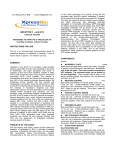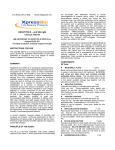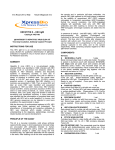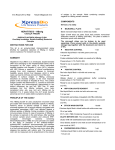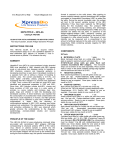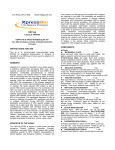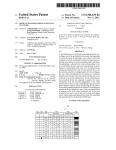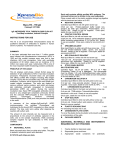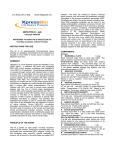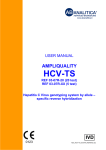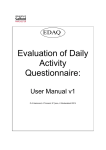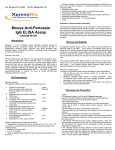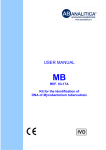Download HEPATITIS A – HAV-IgG
Transcript
For Research Use Only Not for Diagnostic Use sulfuric acid. No or low color developing suggests the presence of antibodies to HAV in the sample. COMPONENTS 96 Tests HEPATITIS A – HAV-IgG Catalog #: WA1296 IgG ANTIBODY TO HEPATITIS A VIRUS ELISA KIT Two-Step Incubation, Competition Principle INSTRUCTIONS FOR USE The kit is an enzyme linked-immunosorbent assay (ELISA) for qualitative determination of IgG-class antibodies to human hepatitis A virus (HAV-IgG) in serum or plasma. For Research Use Only SUMMARY Hepatitis A is a self-limited disease and chronic stage or other complications are rare. Infections occur early in life in areas with poor sanitation and crowded living conditions. With improved sanitation and hygiene, infections are delayed and consequently the number of persons susceptible to the disease increases. Because the disease is transmitted through the fecal-oral route, in dense populated regions an outbreak can arise from single contaminated source. The cause of hepatitis A is hepatitis A virus (HAV)-non enveloped positive strand RNA virus with a linear single strand genome, encoding for only one known serotype. HAV has four major, structural polypeptides and it localizes exclusively in the cytoplasm of human hepatocites. The infection with HAV induces strong immunological response and elevated levels first of IgM and then IgG are detectable within a few days after the onset of the symptoms. IgG is an indicator of past infection and immunity to HAV. PRINCIPLE OF THE ASSAY This HAV-IgG ELISA kit is based on solid phase, one-step incubation competitive principle ELISA method. If HAV IgG antibodies present in the sample, they compete with monoclonal HAV-IgG antibodies labeled with horseradish peroxidase (HRP-Conjugate) for a fixed amount of purified HAV antigens pre-coated in the wells. When no HAV-IgG presents in the sample, the HRP labeled HAV-IgG will be bound with the antigens inside the wells and the unbound HRP-Conjugate is removed during washing. Chromogen A and B solutions are added into the wells and during incubation, the colorless Chromogens are hydrolyzed by the bound HRP-Conjugate to a blue-colored product. The blue color turns yellow after stopping the reaction with MICROWELL PLATE 1 plate Blank microwell strips fixed on white strip holder. The plate is sealed in aluminum pouch with desiccant. 12×8/8×12-well strips per plate. Each well contains purified HAV antigens. The microwell strips can be broken to be used separately. Place unused wells or strips in the plastic sealable storage bag together with the desiccant and return to 2-8ºC. NEGATIVE CONTROL 1 vial Yellowish liquid filled in a vial with green screw cap. 0.5ml per vial. Protein-stabilized buffer tested non reactive for HAV-IgG. Preservatives: 0.1% ProClin 300. Ready to use as supplied. Once open, stable for one month at 2-8ºC. POSITIVE CONTROL 1 vial Red color liquid filled in a vial with red screw cap. 0.5ml per vial. HAV-IgG antibodies diluted in proteinstabilized buffer. Preservatives: 0.1% ProClin 300. Ready to use as supplied. Once open, stable for one month at 2-8ºC HRP-CONJUGATE REAGENT 2 vials Red liquid filled in a white vial with red screw cap. 3ml per vial. Horseradish peroxidase-conjugated HAVIgG antibodies. Ready to use as supplied. Once open, stable for one month at 2-8ºC. STOCK WASH BUFFER 1 bottle Colorless liquid filled in a clear bottle with white screw cap. 50 ml per bottle. PH 7.4 20 × PBS (Contains Tween-20 as a detergent) DILUTE BEFORE USE -The concentrate must be diluted 1 to 20 with distilled/deionizer water before use. Once diluted, stable for one week at room temperature or for two weeks at 2-8ºC. CHROMOGEN SOLUTION A 1 vial Colorless liquid filled in a white vial with green screw cap. 7ml per vial. Urea peroxide solution. Ready to use as supplied. Once open, stable for one month at 2-8ºC. CHROMOGEN SOLUTION B 1 vial Colorless liquid filled in a black vial with black screw cap. 7ml per vial TMB solution (Tetramethyl benzidine dissolved in citric acid). Ready to use as supplied. Once open, stable for one month at 2-8ºC. STOP SOLUTION 1 vial Colorless liquid filled in a white vial with white screw cap. 7ml per vial. Diluted sulfuric acid solution (2.0M H2SO4). PLASTIC SEALABLE BAG 1 unit For enclosing the strips not in use. CARDBOARD PLATE COVER 2 sheets To cover the plates during incubation and prevent evaporation or contamination of the wells. PACKAGE INSERTS 1 copy ADDITIONAL MATERIALS AND INSTRUMENTS REQUIRED BUT NOT PROVIDED 1. 2. Freshly distilled or deionized water. Disposable gloves and timer. 3. Appropriate waste containers for potentially contaminated materials. 4. Disposable V-shaped troughs. 5. Dispensing system and/or pipette (single or multichannel), disposable pipette tips. 6. Absorbent tissue or clean towel. 7. Dry incubator or water bath, 37±0.5ºC. 8. Microshaker for dissolving and mixing conjugate with samples. 9. Microwell plate reader, single wavelength 450nm or dual wavelength 450nm and 630nm. 10. Microwell aspiration/wash system. SPECIMEN COLLECTION,TRANSPORTATION AND STORAGE • • Sample Collection: Either fresh serum or plasma samples can be used for this assay. Blood collected by venipuncture should be allowed to clot naturally and completely. Care should be taken to ensure that the serum samples are clear and not contaminated by microorganisms. Any visible particulate matters in the sample should be removed by centrifugation at 3000 RPM (round per minutes) for 20 minutes at room temperature or by filtration on 0.22u filters. Plasma samples collected into EDTA, sodium citrate or heparin may be tested, but highly lipaemic, icteric, or hemolized samples should not be used as they can give false results in the assay. Do not heat inactivate samples. This can cause sample deterioraration. Transportation and Storage: Store samples at 28ºC. Samples not required for assaying within 3 days should be stored frozen (-20ºC or lower). Avoid multiple freeze-thaw cycles. SPECIAL INSTRUCTIONS FOR WASHING 1. A good washing procedure is essential to obtain correct and precise analytical data. 2. It is therefore recommended to use a good quality ELISA microplate washer, maintained at the best level of washing performances. In general, no less than 5 automatic washing cycles with dispensing of 350400μl/well, are sufficient to avoid false positive reactions and high background (all wells turn yellow). 3. To avoid cross-contaminations of the plate with sample or HRP-conjugate, after incubation do not discard the content of the wells, but allow the plate washer to aspirate it automatically. 4. Anyway, we recommend calibrating the washing system on the kit itself in order to match the declared analytical performances. Assure that the microplate washer’s liquid dispensing channels are not blocked or contaminated, and sufficient volume of Wash buffer is dispensed each time into the wells. 5. In case of manual washing, we suggest to perform at least 5cycles, dispensing 350-400μl/well and aspirating the liquid for 5times. If poor results (high background) are observed, increase the washing cycles or soaking time per well. 6. In any case, the liquid aspirated out the strips should be treated with a sodium hypochlorite solution (final concentration of 2.5%) for 24 hours, before liquids are disposed in an appropriate way. 7. The concentrated Washing solution should be diluted 1 to 20 before use. For one plate, mix 50 ml of the concentrate with 950ml of water for a final volume of 1000ml diluted Wash Buffer. If less than a whole plate is used, prepare the proportional volume of solution. STORAGE AND STABILITY The components of the kit will remain stable through the expiration date indicated on the label and package when stored between 2-8 ºC, do not freeze. To assure maximum performance of this HAV-IgG ELISA kit, during storage protect the reagents from contamination with microorganism or chemicals. PRECAUTIONS AND SAFETY This kit is intended FOR RESEARCH USE ONLY The ELISA assay is a time and temperature sensitive method. To avoid incorrect result, strictly follow the test procedure steps and do not modify them. Do not exchange reagents from different lots, or use reagents from other commercially available kits. The components of the kit are precisely matched as to achieve optimal performance during testing. 2. Make sure that all reagents are within the validity indicated on the kit box and are of the same lot. Never use reagents beyond the expiry date stated on reagents labels or on the kit box. 3. CAUTION - CRITICAL STEP: Allow the reagents and samples to stabilize at room temperature (18-30ºC) before use. Shake reagent gently before, and return to 2-8ºC immediately after use. 4. Use only sufficient volume of sample as indicated in the procedure steps. Failure to do so may cause in low sensitivity of the assay. 5. Do not touch the bottom exterior of the wells; fingerprints or scratches may interfere with microwell reading. 6. When reading the results, ensure that the plate bottom is dry and there are no air-bubbles inside the wells. 7. Never allow the microplate wells to dry after the washing step. Immediately proceed to the next step. Avoid the formation of air-bubbles when adding the reagents. 8. Avoid assay steps long time interruptions. Assure same working conditions for all wells. 9. Calibrate the pipette frequently to assure the accuracy of samples/reagents dispensing. Always use different disposal pipette tips for each specimen and reagents as to avoid cross-contaminations. Never pipette solutions by mouth. 10. The use of automatic pipettes is recommended. 11. Assure that the incubation temperature is 37ºC inside 1. the incubator. 12. When adding samples, avoid touching the well’s bottom with the pipette tip. 13. When reading the results with a plate reader, it is recommended to determine the absorbance at 450nm or at 450nm with reference at 630nm. 14. All specimens from human origin should be considered as potentially infectious. 15. Materials from human origin may have been used in the kit. These materials have been tested with tests kits with accepted performance and found negative for antibodies to HIV ½, HCV, TP and HBsAg. However, there is no analytical method that can assure that infectious agents in the specimens or reagents are completely absent. Therefore, handle reagents and specimens with extreme caution as if capable of transmitting infectious diseases. Strict adherence to GLP (Good Laboratory Practice) regulations can ensure the personal safety. Never eat, drink, smoke, or apply cosmetics in the assay laboratory. 16. Bovine derived sera may have been used in this kit. Bovine serum albumin (BSA) and fetal calf sera (FCS) are derived from animals from BSE/TSE freegeographical areas. 17. The pipette tips, vials, strips and sample containers should be collected and autoclaved for 1hour at 121ºC or treated with 10% sodium hypochlorite for 30minutes to decontaminate before any further steps for disposal. 18. The Stop solution (2M H2SO4 ) is a strong acid. Corrosive. Use it with appropriate care. Wipe up spills immediately or wash with water if come into contact with the skin or eyes. ProClin 300 used as a preservative can cause sensation of the skin. 19. The enzymatic activity of the HRP-conjugate might be affected from dust, reactive chemical, and substances like sodium hypochlorite, acids, alkalis etc. Do not perform the assay in the presence of such substances. 20. Materials Safety Data Sheet (MSDS) available upon request. If using fully automated microplate processing system, during incubation, do not cover the plates with the plate cover. The tapping out of the remainders inside the plate after washing, can also be omitted. Step 3 Step 4 Step 5 Step 6 Step 7 Step 8 Step 9 C1, D1) two Positive control (e.g. D1, F1) and one Blank (e.g. A1, neither samples nor HRPConjugate should be added into the Blank well). If the results will be determined by using dual wavelength plate reader, the requirement for use of Blank well could be omitted. Use only number of strips required for the test. Adding Sample: Add 50µl specimen, 50µl Negative control and 50µl Positive control into their respective wells Note: Use a separate disposal pipette tip for each specimen, Negative, Positive Control as to avoid crosscontamination. Adding HRP-Conjugate: Add 50µl of antibody HRP-Conjugate to each well except the blank. Mix by tapping the plate gently. Incubating: Cover the plate with the plate cover and incubate the plate for 60 minutes at 37°C. It is recommended to use thermostat-controlled water tank to assure the temperature stability and humidity during incubation. If dry incubator is used, do not open the door frequently. Washing: Remove and discard the plate cover. Wash each well 5 times with diluted Washing buffer. Each time allow the microwells to soak for 30-60 seconds. After the final washing cycle, turn down the plate onto blotting paper or clean towel, and tap it to remove any remainders. Coloring: Add 50µl of Chromogen A and 50µl Chromogen B solution into each well cover the plate with plate cover and mix gently. Incubate the plate at 37ºC for 15 minutes avoiding light. The enzymatic reaction between the Chromogen solutions and the HRP-Conjugate produces blue color in Negative control and negative sample wells. Stopping Reaction: Remove and discard the plate cover. Using a multichannel pipette or manually, add 50µl Stop solution into each well and mix gently. Intensive yellow color develops in Negative control and negative sample wells. Measuring the Absorbance: Calibrate the plate reader with the Blank well and read the absorbance at 450nm. If a dual filter instrument is used, set the reference wavelength at 630nm. Calculate the Cut-off value and evaluate the results. (Note: read the absorbance within 5 minutes after stopping the reaction.) ASSAY PROCEDURE Step 1 Reagents Preparations: Allow all the reagents and samples to reach room temperature (1830°C) for at least 15-30minutes. Check the Wash buffer concentrate for the presence of salt crystals. If crystals have formed in the solution, resolubilize by warming at 37ºC until crystals dissolve. Dilute the Wash Buffer 1 to 20 with distilled or deionized water. Only use clean vessels to dilute the buffer. Step 2 Numbering Microwells: Set the strips needed in strip-holder and number sufficient number of wells including three Negative control (e.g. B1, INTERPRETATION OF RESULTS AND QUALITY CONTROL Each microplate should be considered separately when calculating and interpreting results of the assay, regardless of the number of plates concurrently processed. The results are calculated by relating each sample’s optical density (OD) value to the Cut-off value (C.O.) of the plate. If the Cut-off reading is based on single filter plate reader, the results should be calculated by subtracting the Blank well OD value from the print report values of samples and controls. In case the reading is based on dual filter plate reader, do not subtract the Blank well OD from the print report values of samples and controls. 2. 1. Calculation of Cut-off value (C.O.) = *NC × 0.5 *NC = the mean absorbance value for three negative control 3. Example of Cut-off calculation: Calculation of NC Well No B1 C1 D1 Negative controls OD values 1.725 1.727 1.729 NC=1.729 Calculation of Cut-off (C.O.)= 1.727 × 0.5 =0.863 INDICATIONS OF INSTABILITY OR DETERIORATION OF THE REAGENTS 1. If one of the Negative Control values does not meet the Quality control range specifications, it should be discarded, and the mean value is calculated again using the remaining two values. If more than one negative control OD value does not meet the Quality control range specifications, the test is invalid and must be repeated. 2. Quality control range: 1. The OD value of the Blank well, which contains only Chromogens and Stop solution, is less than 0.080 at 450 nm. 2. The OD value of the Negative control must be equal to or greater than 0.800 at 450/630nm or at 450nm after blanking. 3. The OD value of the Positive control must be less than 0.100 at 450/630nm or at 450nm after blanking. 3. Interpretations of the results: (S = the individual absorbance (OD) of each specimen) 2. Please do not use this kit beyond the expiration indicated on the kit box and reagent labels. REFERENCES: 2. 3. 4. 5. 6. LIMITATIONS 1. Non-repeatable positive result may occur due to the general biological characteristics of the ELISA assays. The kit is design to achieve very high performance Values of the Positive or Negative controls ,which are out of the indicated Quality control range, are indicator of possible deterioration of the reagents and/or operator or equipment errors. In such case, the results should be considered as invalid and the samples must be retested. In case of constant erroneous results classified as due to deterioration or instability of the reagents, immediately substitute the reagents with new ones. If after mixing of the Chromogen A and B solutions into the wells, the, the color of the mixture turns blue within few minutes, do not continue carrying out the testing and replace the reagents with fresh ones. VALIDITY 1. Negative Results (S/C.O.>1): samples giving an absorbance greater than the Cut-off value are considered negative ,which indicates that no antibodies to HAV have been detected using this HAV-IgG ELISA kit. Positive Results (S/C.O. ≤1): samples giving an absorbance less than, or equal to the Cut-off value are initially reactive for this assay, which indicates that antibodies to HAV have probably been detected. Retesting in duplicates of any reactive sample is recommended. Repeatedly reactive samples can be considered positive for antibodies to HAV Borderline (S/CO =0.9-1.1): Samples with absorbance to Cut-off ratio between 0.9 and 1.1 are considered borderline. Retesting of these samples in duplicates is recommended. Repeatedly reactive samples could be considered positive for antibodies to HAV. characteristics of sensitivity and specificity. Antibodies may be undetectable during the early stages of the disease and in some immunosuppressed individuals. Positive results must be confirmed with another available method Common sources for mistakes: kits beyond the expiry date, bad washing procedures, contaminated reagents, incorrect assay procedure steps, insufficient aspiration during washing, failure to add samples or reagents, equipment, timing, volumes, sample nature and quality. The prevalence of the marker will affect the assay’s predictive values. 7. J.V. PARRY, (1981). Hepatitis A infection: guidelines for development of satisfactory assays for laboratory diagnosis. The Institute of Medical Laboratory Sciences 38, 303-311. Lindberg J., Frosner G., Hansson B.G. et al. Serologic markers of hepatitis A and B in chronic active hepatitis. Scandinavian Journal of Gastroenterology, 13:525-527, 1978. Battegay M, Gust ID, and Feinstone SM. Hepatitis A virus. In: Mandell GL, Bennett JE, and Dolin R, eds. Principles and Practice of Infectious Diseases, 4th ed. New York, Churchill Livingstone, 1995:1636-1656. Sjogren MH, Tanno H, Fay O, et al. Hepatitis A virus in stool during clinical relapse. Ann Intern Med 1987;106:221-6. Lemon SM. The natural history of hepatitis A: the potential for transmission by transfusion of blood or blood products. Vox Sang 1994;67(suppl 4):19-23. Bower WA, Nainan OV, Margolis HS. Duration of viremia in naturally-acquired hepatitis A viral infections. [Abstract 103] In: Abstracts of the Infectious Diseases Society of America 35th Annual Meeting. Alexandria, VA: Infectious Diseases Society of America, 1997. Liaw YF, Yang CY, Chu CM, Huang MJ. Appearance and persistence of hepatitis A IgM antibody in acute clinical hepatitis A observed in an outbreak. Infection 8. 1986;14:156-8. Stapleton JT. Host immune response to hepatitis A virus. J Infect Dis 1995;171(suppl 1):S9-14. Express Biotech International 503 Gateway Drive West Thurmont, MD 21788 USA Tel: 301-228-2444 Fax: 301-560-6570 Toll Free: 888-562-8914 www.xpressbio.com [email protected]





